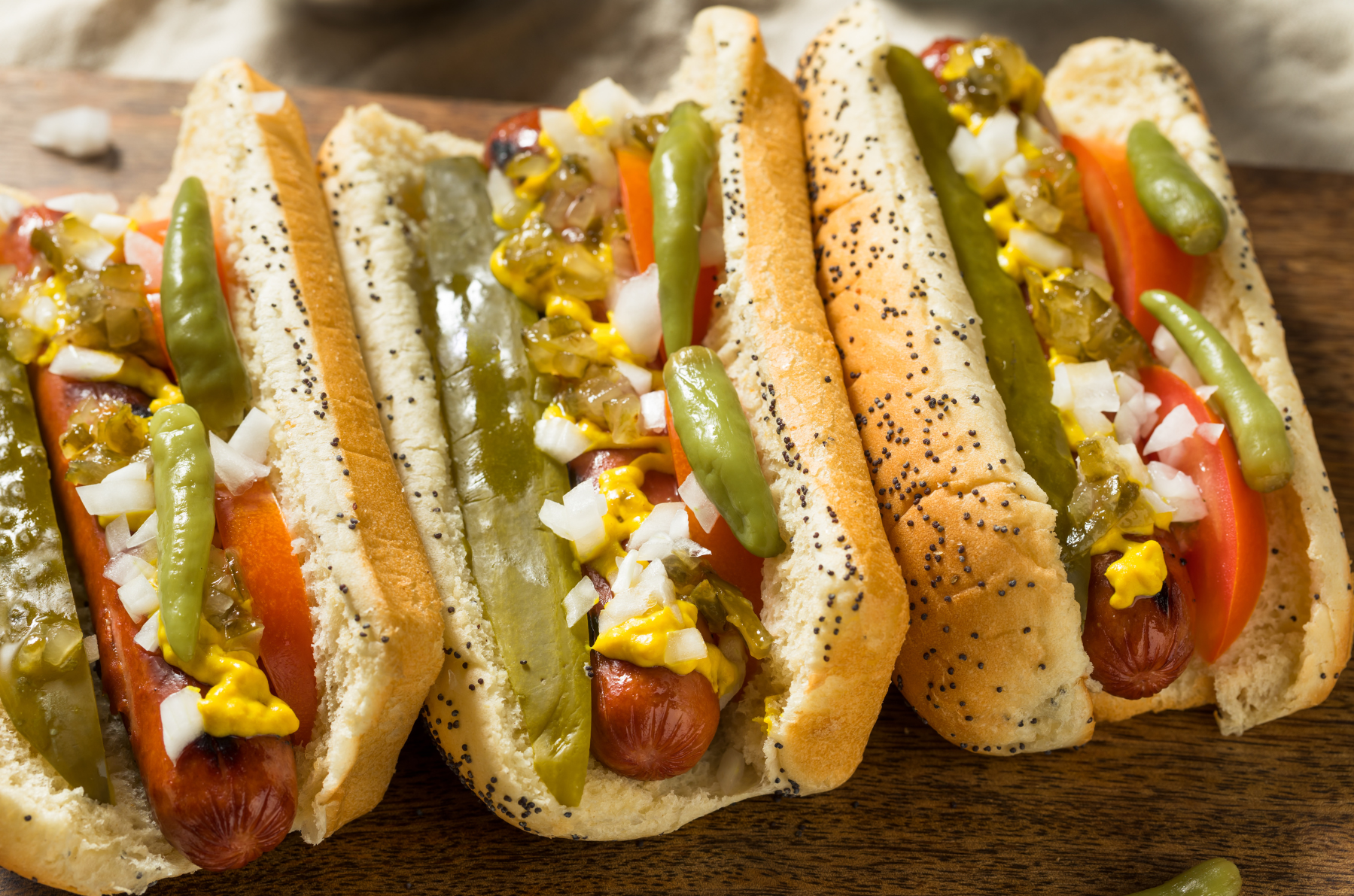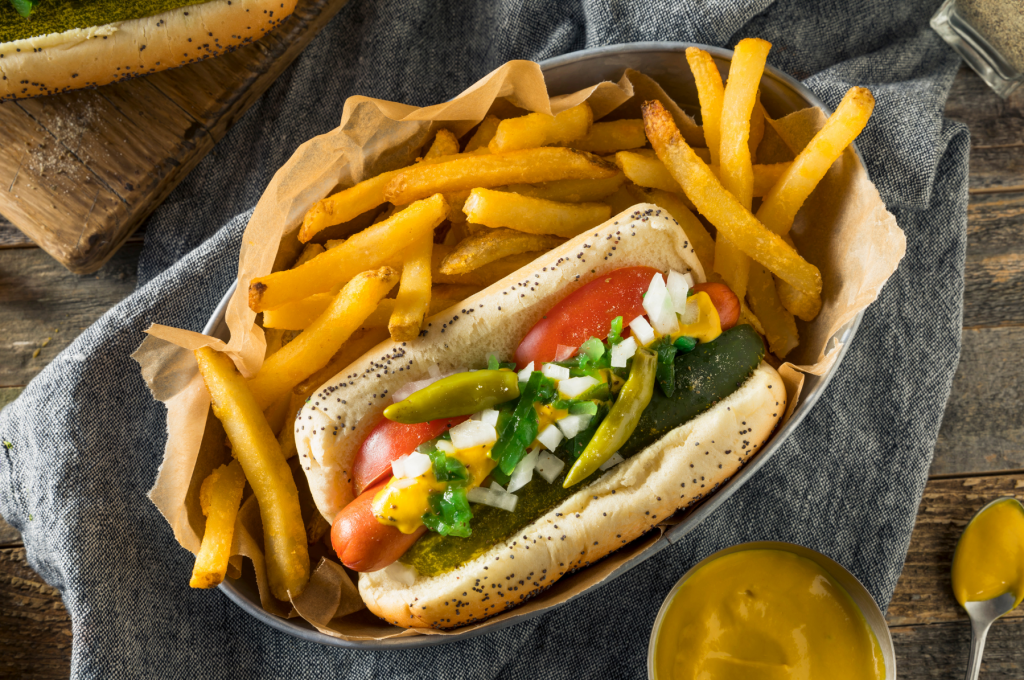
How Chicago Dragged the Hot Dog Through the Garden
Published on August 17, 2023
The Chicago hot dog is one of the flavors you’ll encounter during eATLAS’ tour of classic Chicago foods in the Loop. We also have a tour inspired by the FX/Hulu hit series The Bear, where you can see several of the restaurants Sydney visited when creating the “Chaos Menu.”
By Dave Lifton (@daveeatschicago)
Portable, cheap, and delicious: hot dogs are perhaps America’s ultimate street food. While Chicago doesn’t claim to have invented the hot dog—the history of sausages can be traced back to ancient civilizations—the city is responsible for arguably the definitive take on it.
Frankfurters came to Chicago from Germans, who started emigrating to the city in the mid-19th century. During the Civil War, the halting of trade along the Ohio River helped Chicago overtake Cincinnati as America’s center for pork processing, which led to the opening of the Union Stock Yards in 1865. Local German butchers now had a seemingly bottomless supply of pork for their sausages.
As with so much else in Chicago, the 1893 World’s Columbian Exposition became the catalyst for innovation. Brothers-in-law Emil Reichel and Samuel Ladany, who had left Vienna, Austria for Chicago in 1890, were Jewish and created an all-beef sausage with a natural casing and sold it at the fairgrounds. With the profits, the pair incorporated a year later as Vienna Beef and opened a shop on S. Halsted St. on the Near West Side.
Between the flavor of the hot dog and the perception that beef was safer and healthier than pork, Vienna Beef took off. Before long, the company was supplying others, and hot dog stands and carts began popping up all over the city.
Then came the Great Depression. In an effort to give people as much food as possible while still making a profit, vendors began piling vegetables onto the hot dog, calling it a “Depression Sandwich” and charging five cents. Over the years, it morphed into what we know as the colorful “dragged through the garden” Chicago-style hot dog and consists of an all-beef sausage—boiled to give it a snap, although many places will grill them over a flame—inside a steamed poppy seed bun with the following condiments, layered in a specific order: yellow mustard, neon green relish, diced white onions, dill pickle spear, tomato half-slices, sport peppers, and a dash of celery salt.

It is, in essence, a perfect bite of food. The slightly smoky frankfurter is complemented by the condiments, which provide spice, sweetness, heat, acidity, and different layers of crunch in harmony, with no single flavor overpowering the others. In the 21st century, thanks to the growth of food media and celebrity chefs, more Americans understand how those elements comprise our favorite foods. A world-class chef would look to balance those same components in trying to engineer the ideal hot dog today, if not those exact ingredients. And Chicago street vendors figured all that out decades ago.
But there’s more to its appeal. The Chicago-style hot dog is also a culinary microcosm of the ethnic communities that populated the Near West Side at the time. The sausage, poppy seed bun, and dill pickles came from the German and Jewish immigrants, while the sport peppers and relish were added by the Italians, and the raw tomatoes and onions were Greek in nature. Today, that type of cross-cultural cuisine is called “fusion.” In Chicago, we just call it “lunch.”
Even those who have never tried a Chicago dog know that ketchup is expressly forbidden. There are several explanations given as to why it’s not allowed, ranging from the sweetness overpowering the meat to not messing with tradition. But the most plausible reason is that it’s redundant; the condiments provide everything ketchup does, albeit in a subtler manner.
Due to concerns about sanitary conditions, food carts were eventually banned in Chicago, and hot dog vendors opened full-service restaurants that also serve another local staple—the Italian beef sandwich—and other quickly prepared items. These days, there are more than 1,800 hot dog stands all over the Chicago area, which is more than there are McDonald’s, Burger King, and Wendy’s combined. It is estimated that 90 percent of them use Vienna Beef products, not just the frankfurters but also the condiments. The remaining 10 percent either use other suppliers or their own recipe.
Over the years, some hot dog stands, such as Wolfy’s in West Ridge and Superdawg in Norwood Park, have become local institutions through their retro, eye-catching signs, and Lincoln Park’s The Wiener’s Circle is famous for its staff that serves up insults with its char-grilled dogs. Portillo’s started in the western suburb of Villa Park, Ill., in 1963 and has since grown to more than 75 locations in 10 states.
The Chicago-style hot dog grew from being an inexpensive form of sustenance during the Depression to a source of civic pride. You can see depictions of it in souvenir stands all over the city and as tattoos. It has rightfully earned its place as a local culinary icon, and its slot in the pantheon of Americana.

The Adventure starts when you say it does.
All eATLAS Adventures are designed and built by experienced eATLAS Whoa!Guides. They're always on. Always entertaining. And always ready to go.
Check out our Adventures!